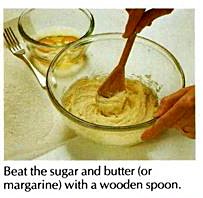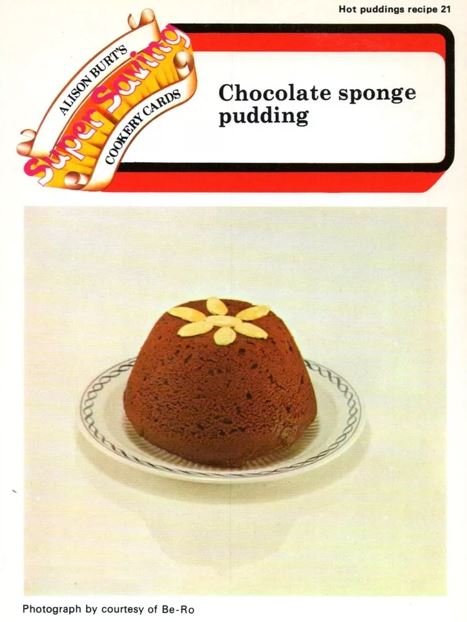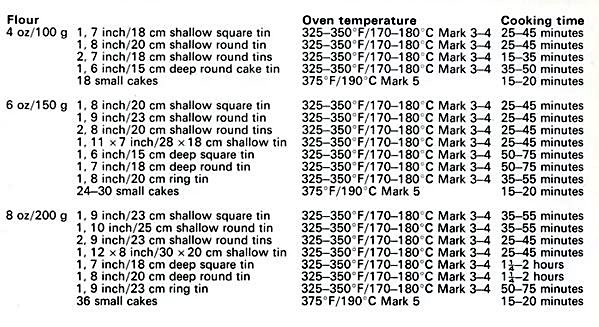
Sponges come in all shapes and sizes, as well as flavours. But making the perfect sponge can create its own problems if you don’t follow the recipe to the letter. Just follow the guidelines below to make the perfect sponge every time!!
How to Make a Sponge



The ingredients required for a Victoria sponge are often referred to as 4:4:4; that is 4oz/100g flour, 4oz/100g caster sugar, 4oz/100g fat and 2 large eggs, which, when shelled, also weigh 4oz/100g. You can use self-raising flour or plain flour plus Vi level teaspoon baking powder. Use caster sugar only; coarser-grained sugars such as granulated and demerara produce a speckled finish. Fat should be butter or margarine or a mixture of both. All ingredients should be at room temperature before you begin to cream the fat and sugar. Creaming is beating the fat and sugar together with a wooden spoon until the mixture is creamy coloured and fluffy textured. Lightly beat the eggs and beat them into the creamed mixture a little at a time, but if the mixture looks as though it might curdle, beat in 1 level tablespoon of the sifted flour with the last additions of egg. Finally fold in the sifted flour or flour and baking powder using a large metal spoon, stopping immediately the flour is incorporated. Do not beat it.
A cooked sponge is golden brown, well risen and shrinking slightly from the edges of the tin. It should spring back when you press the centre lightly with the tip of one finger.
Mixer method
Follow the method given above but use softened butter or margarine. Begin beating with your mixer at a slow speed, increasing the speed as the butter and sugar mixture softens. There’s a danger of overbeating with a mixer; if you do, you beat out all the air beaten in during the creaming. Stop as soon as the mixture is pale and fluffy and add the eggs one at a time. Fold in the flour as before.
Quantities and tin sizes
The amounts given here (4:4:4) can be increased to 6:6:6, which is 6oz/ 175g fat, 6oz/175g sugar, 6oz/175g flour and 3 large eggs, or to 8:8:8, or more, provided you increase all the ingredients in proportion.
A 4:4:4 mixture will make two 7in/ 18cm round sponges for sandwiching, one 6in/15cm deep round cake, or 18 small buns.
A 6:6:6 mixture will make two 8in/ 20cm round sponges for sandwiching, one 6in/15cm deep square cake, one 7in/18cm deep round cake, one 9in/ 23cm shallow round cake, or 26 to 30 small buns.
An 8:8:8 mixture will make two 9in/ 23cm round sponges for sandwiching, one 10in/25cm shallow round cake, one 7in/18cm deep square cake, or 33 to 36 small buns.
Unrisen, heavy sponge?
1. You used plain flour with no raising agent
2. You didn’t cream the butter and sugar well so that not enough air was incorporated.
3. You used a mixer and left it creaming the fat and sugar for too long, or you beat it too long after the eggs were added.
4. You beat in the flour which knocks out the air beaten into the creamed mixture. Always gently fold in the flour.
5 You didn’t bake the mixture immediately but left it standing too long in the bowl or tins.
What to do now: Turn the sponge into a trifle, make sponge truffle cakes, or turn it into a pudding by crumbling it, beating in egg to make a soft mixture and steaming it in a basin for 1 hour. Serve with a sauce.
Sponge sunk in the middle?
1. The cake wasn’t quite cooked when you removed it from the oven.
2. Perhaps there was too much raising agent, baking powder added to self-raising flour or a rounded measure of baking powder for instance.
3. The raising agent was not sifted with the flour and therefore was not evenly distributed throughout the mixture.
What to do now: Cut out the centre of the cake using a cup or small plate as a guide. Ice the cake as a ring sponge for tea or fill the centre with fruit, spread with cream and serve as a pudding.
Sponge overflows the cake tin?
1 The cake tin or tins were probably too small for the mixture. To be on the safe side, never spoon in mixture over the half-way mark.
2 Too much raising agent can cause this to happen. Either raising agent plus self-raising flour was used or your measure of raising agent was rounded or heaped rather than level. What to do now: Trim the edge of the cake flush with the cake tin or tins and cover the cake(s) with icing.
© Copyright The Hamlyn Publishing Croup Limited/Kathie Webber MCMIXXXI Printed in England
Now you’ve perfected the art of a perfect sponge, take a look at a few vintage recipes below.

Serves: 4-6 people
Preparation time: 30 minutes
Cooking time: 1 1/2 hours
A light and delicious pudding which is especially popular with children
Serve with custard or chocolate sauce
- 2 oz/50 g margarine
- 2 oz/50 g castor sugar
- 1 oz/25 g cocoa
- 3 oz/75 g self raising flour
- 1 egg, separated
- 1 tablespoon milk
- few blanched almonds for decoration (optional)
Lightly grease a 1 pint/6 dl pudding basin. Soften the margarine in a mixing bowl, add the sugar and cream together until light and fluffy. Sift the cocoa and flour and gently add them to the creamed mixture with the beaten egg yolk and milk. Whisk the egg white until stiff, fold it into the sponge mixture. Spoon the mixture into the prepared basin. Cover the top of the basin with greased greaseproof paper. Tie under the rim of the basin with string. Place the basin in a steamer over boiling water or in a large saucepan with water to come halfway up the sides of the basin. Steam the sponge pudding for 1 i hours. Turn out of the basin, decorate with the blanched almonds, if liked, and serve.
© Copyright The Hamlyn
Publishing Group Ltd 1975 Printed in U.K.

Cooking time: 20 mins.
Preparation time: 25-30 mins.
Main cooking utensils: Two 7 ins. square sponge sandwich tins, saucepan
Oven temperature:375°F. – Gas Mark 4-5
Oven position: near top
For 8-10 portions you need:
For the sponge:
- 6 oz. butter or margarine
- 6 oz. castor sugar
- 3 large eggs
- 6 oz. self-raising flour
For the filling:
- 2 cooking apples
- Juice of 1/2 lemon
- 3 oz. castor sugar
- Pinch ground cinnamon
- 2 tablespoons water
- 1 oz. walnuts
For the topping:
- 1/4 pint double cream
- Vanilla essence
- 1/2 oz. castor sugar
- Approx. 14 walnut halves
1. Follow method for Sponge (making two halves).There’s a table below to work out quantities
2. Put into the greased and floured sandwich tins.
3. Bake for time and temperature given.
4. Test cakes before removing from oven press gently with finger, if no impression remains cake is cooked -allow to cool.
5. Simmer peeled apples (sliced), with lemon juice, sugar, cinnamon and water, until apples are a soft pulp. Beat thoroughly and cool.
6. Stir in coarsely chopped walnuts.
7. Sandwich cakes together with the apple purge.
8. Whip cream and flavour with vanilla essence and sugar.
9. Spread on cake, decorate with walnuts.
TO SERVE: For tea or as a sweet.
TO VARY: Use other fruits as filling
© Copyright Paul Hamlyn Ltd 1967
Table For Working Out Quantities of Sponge


